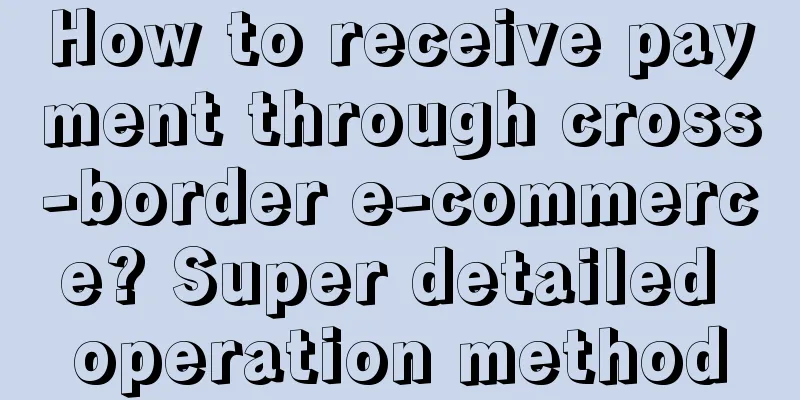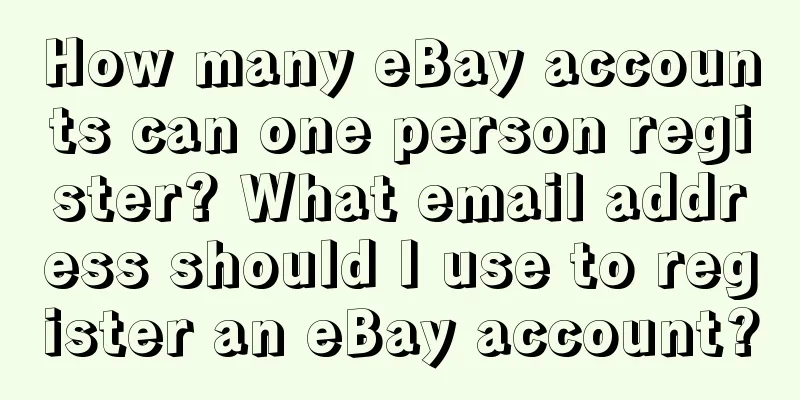How to receive payment through cross-border e-commerce? Super detailed operation method

|
As a way of starting a business, cross-border e-commerce can not only bring profits, but also expand the market. However, for cross-border e-commerce, how to collect payments may be an important issue. This article will discuss this issue and introduce the payment methods of cross-border e-commerce to help cross-border e-commerce accept payments smoothly and make profits. 1. How do personal cross-border e-commerce businesses collect payments? When accepting payments, individual cross-border e-commerce merchants can follow the following steps: Register a payment account: First, individual cross-border e-commerce needs to register a suitable payment account in order to accept international payments. Common payment accounts include PayPal, Stripe, Skrill, etc. Set up payment methods: In the payment account, individual cross-border e-commerce needs to set up their own payment methods. This usually includes bank transfer, credit card payment, e-wallet, etc. Provide payment information: Depending on the payment method selected, individual cross-border e-commerce merchants need to provide corresponding payment information, such as bank account number, credit card number, etc. Generate a payment link or QR code: After completing the above steps, individual cross-border e-commerce users can generate a payment link or QR code through their payment account and embed it into their own online store or electronic invoice to facilitate payment by buyers. Confirm payment: After the buyer completes the payment, the cross-border e-commerce merchant needs to confirm the payment. This usually involves checking the payment record of the payment account and verifying and confirming each payment. 2. What are the payment methods? Individual cross-border e-commerce merchants can choose from a variety of payment methods, depending on the country and region, the type of products sold, and personal preferences. The following are some common payment methods: PayPal: As one of the world's most well-known online payment platforms, PayPal is widely used in cross-border transactions and supports multiple currencies and payment methods. Bank transfer: Individual cross-border e-commerce merchants can provide their own bank account information and allow buyers to pay through bank transfer. This method can directly transfer funds to personal accounts. Alipay: Alipay is a common payment method in the Chinese market. Individual cross-border e-commerce merchants can register and bind their own bank cards to facilitate buyers to pay using Alipay. Credit card payment: Through cooperative payment institutions or banks, individual cross-border e-commerce can accept buyers to pay by credit card. This method is convenient and fast, and can provide a better payment experience. E-wallet: In addition to PayPal and Alipay, there are other e-wallets to choose from, such as Stripe, Skrill, etc. Individual cross-border e-commerce can choose the appropriate e-wallet based on buyer preferences and regional characteristics. It should be noted that different payment methods may have their own fees and operating procedures. Individual cross-border e-commerce businesses need to make comparisons when choosing and consider their own needs and customers’ payment habits. Through the above introduction, we know the methods and common payment methods of individual cross-border e-commerce. Individual cross-border e-commerce can register a suitable payment account and set up their own payment methods. Common payment methods include PayPal, bank transfer, credit card payment, Alipay and other e-wallets. Recommended reading: Which platform should I choose for my personal cross-border e-commerce business? What are the requirements for entry? How much does it cost for personal cross-border e-commerce? Do I need a deposit? Can cross-border e-commerce personal trademarks be registered? What are the regulations? |
<<: How to open a store for a cross-border e-commerce novice? A complete tutorial on opening a store
Recommend
How is Wish's cross-border logistics calculated? What logistics can be sent?
Now, to register a store on the Wish platform, sel...
Live streaming is a new trend. Why are group broadcasts so popular?
The live broadcast industry has ushered in a new r...
After earning 600,000 yuan in two courses, "Crazy Xiao Yang Ge" has made new moves
In the wave of live streaming e-commerce, "Cr...
Pingdaixue has cured every young person with "consumption internal consumption"
Substitution consumption is popular among young pe...
How to advertise on Wish? What is the method?
As one of the cross-border e-commerce platforms, W...
Zhihu novels are conquering Douyin, who will be the next Xiaoshuai and Xiaomei?
Anyone who frequently uses Douyin must have seen t...
Why is the “anti-human” niche track the secret to success for Vlog creators?
In the current fierce competition in the Vlog trac...
Apple forcibly collects "tolls", WeChat and Douyin open up "new routes", and a tough battle is about to begin!
The friction between Apple and WeChat and Douyin i...
I promote innovation in traditional enterprises. Professional ability and understanding of interest relationships are required, but subversion is not required.
This article is very close to the actual situation...
Does Shopify need to ship abroad first? Does Shopify ship by itself?
Shopify is an independent website. This platform i...
Traffic + subsidies + global coverage: why does Douyin e-commerce attach so much importance to "key promotion products"
This year, consumers' demands have begun to ch...
This is too exciting. This operation analysis strategy is really on point.
Faced with data fluctuations, operators often feel...
Hema feels like it's back on track
This article deeply analyzes the strategic adjustm...
What are the requirements for Amazon video ads? How to upload them?
Now after opening a store on Amazon, everyone will...
How to set up Shopee logistics? What are the procedures?
When you open a store online, you must understand ...









